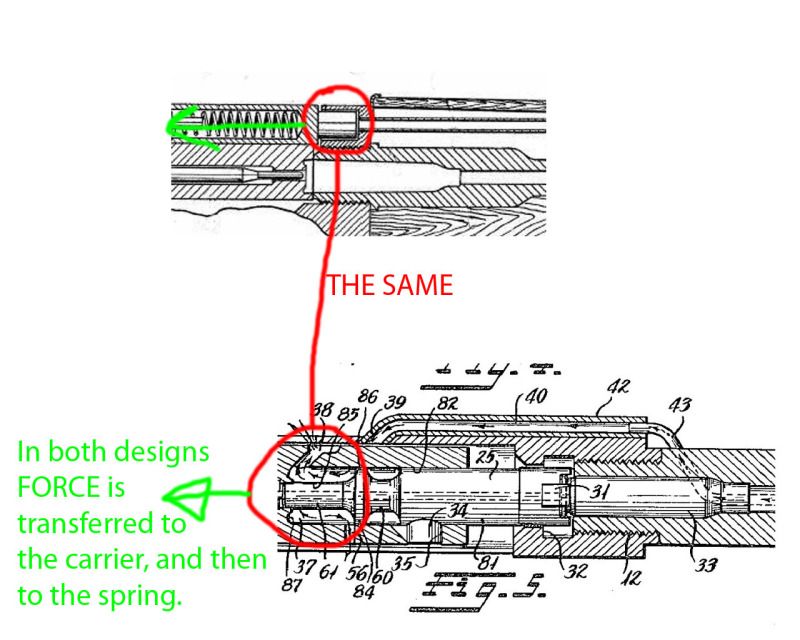|
||||||||||||||||||||||||||||||||||||||
There may be force put on the bolt from the rear but there will not be any movement forward of the bolt like alot seem to think when they bring up the expanding gases, I guess I could have explained that a bit better. Alot of times you see people mention that when the gas expands its puts forward pressure on the bolt pushing it forward and reducing stress on the bolt lugs. This is not true.
I also notice alot of times on bolts the front part of the bolt lugs will have finish wear, I would reckon this comes from the locking and unlocking of the bolt slightly rubbing against the barrel extension, correct me if I am wrong here?
Last edited by sinlessorrow; 11-02-12 at 23:34.
Even if it doesnt move, there is pressure pushing foreward on the bolt. You have the force of the main propelent pushing back, and this pushing foreward(to a lesser extent). Some of the forces cancel reducing the overall value of the rearward force vector. This will reduce friction on the lugs. If a sled is on the ground and you lay on it, it doesnt move, but there is much more static friction to overcome, and after that there is still more friction. This will cause the sled to get a hole much quicker.
This is true, there is gas pushing the bolt forward but it does not "move" forward like is generally said.
Not only is there practically no room(maybe a thousands of an inch as MM said, though I am still doubtful that little bit would even make any difference.) and the rearward force from the chamber there is no way for the bolt to actually move forward.
In order for the gases to move the bolt forward, there must be greater pressure inside the BCG than inside the bore. Pressure inside the BCG will either be less than or equal to the pressure inside the bore. Never greater. The pressure inside the BCG cannot move the bolt forward. What happens is that the pressure inside the bore simply drops enough that it's no longer exerting back thrust
Last edited by MistWolf; 11-03-12 at 00:43.
The number of folks on my Full Of Shit list grows everyday
I am American
I disagree with the characterization of Stoner's design as a Piston system. Yes it does involve a stationary piston as stated in his patent, but the system does more closely resemble an impingement system. The gases still transfer their energy to the carrier, as with the DI example in the first post, stoner just moved this transfer to a different place that is in line with the barrel. In Stoner's design none of the energy is transferred to the piston, it goes to the carrier which simply drags the bolt along for the ride.The cutaway also shows how the gas is sent behind the bolt and gives an idea of how the piston in the system works.

Last edited by Treiz; 11-03-12 at 01:52.
M&P 9 & 9c, AR-15
They are not the same. Do not forget for every reaction, there is an equal and opposite reaction. Draw the arrow in the opposite direction of the thrust to the carrier and what will you find? In teh Ljungman system, it's the incoming gas. In the AR, it's the piston. Another significant difference is the AR uses an expansion chamber.
What is the difference between a piston & cylinder system where the piston moves or the cylinder moves?
Stoner himself wrote that his system is not a DI system. Was he wrong?
Last edited by MistWolf; 11-03-12 at 02:15.
The number of folks on my Full Of Shit list grows everyday
I am American
... and behind the piston is more gas. The gas in both cases is trying to expand in ALL directions. As far as the transfer of force is concerned the piston is no different from the walls of the gas tube in either design, or the ground under a rocket.In teh Ljungman system, it's the incoming gas. In the AR, it's the piston.
M&P 9 & 9c, AR-15
A piston is a component of reciprocating engines, reciprocating pumps, gas compressors and pneumatic cylinders, among other similar mechanisms. It is the moving component that is contained by a cylinder and is made gas-tight by piston rings.
Sounds like a piston to me.
Wow, can’t believe this thread resurfaced.
In thinking if piston systems, first think of internal combustion systems. The ignition of the gun powder, like the gas-air mixture, causes an expansion. The bullet (piston in an engine), is forced to move down the bore (cylinder). There is no connecting rod to the bullet, so the bullet continues onward until over come by other forces. The expanding gases exhaust into the gas port and out of the muzzle, much the same as in an engine via the exhaust valve.
The gas tube, gas key, and gas chamber inside the bolt carrier make up the other cylinder in this system. The gases expand in this ‘cylinder’ until enough force overcomes the inertia of the BCG-buffer, and the friction created by surface contact areas felt by the BCG-buffer. The bolt tail area would be considered a stationary piston.
The conception of this being a piston system, because the bolt acts like a piston, though initially stationary, and not a direct impingement is FALSE. Expanding gases are the actuating (impinging) force in this system, NOT THE BOLT! Even in the labeled ‘Piston system’ for the AR, the expanding gases STILL provide the impinging force for the motion of the BCG.
Both systems use an expanding gas to impart (impinge) a force to move a mechanical system after the mechanical system’s inertia is overcome. Only difference in the two AR systems would be the physical size of second ‘cylinder’, where and the impingement takes place, and where the gases are exhausted.
Bookmarks